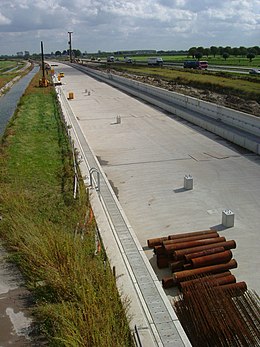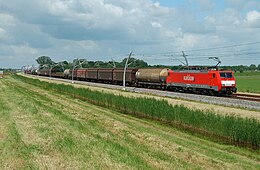Betuweroute
This article needs to be updated. (April 2022) |
| Betuweroute | ||||||||||||||||||||||||||||||||||||||||||||||||||||||||||||||||||||||||||||||||||||||||||||||||||||||||||||||||||||||||||||||||||||||||||||||||||||||||||||||||||||||||||||||||||||||||||||||||||||||||||||||||||||||||||||||||||||||||||||||||||||||||||||||||||||||||||||||||||||||||||||||||||||||||||||||||||||||||||||||||||||||||||||||
|---|---|---|---|---|---|---|---|---|---|---|---|---|---|---|---|---|---|---|---|---|---|---|---|---|---|---|---|---|---|---|---|---|---|---|---|---|---|---|---|---|---|---|---|---|---|---|---|---|---|---|---|---|---|---|---|---|---|---|---|---|---|---|---|---|---|---|---|---|---|---|---|---|---|---|---|---|---|---|---|---|---|---|---|---|---|---|---|---|---|---|---|---|---|---|---|---|---|---|---|---|---|---|---|---|---|---|---|---|---|---|---|---|---|---|---|---|---|---|---|---|---|---|---|---|---|---|---|---|---|---|---|---|---|---|---|---|---|---|---|---|---|---|---|---|---|---|---|---|---|---|---|---|---|---|---|---|---|---|---|---|---|---|---|---|---|---|---|---|---|---|---|---|---|---|---|---|---|---|---|---|---|---|---|---|---|---|---|---|---|---|---|---|---|---|---|---|---|---|---|---|---|---|---|---|---|---|---|---|---|---|---|---|---|---|---|---|---|---|---|---|---|---|---|---|---|---|---|---|---|---|---|---|---|---|---|---|---|---|---|---|---|---|---|---|---|---|---|---|---|---|---|---|---|---|---|---|---|---|---|---|---|---|---|---|---|---|---|---|---|---|---|---|---|---|---|---|---|---|---|---|---|---|---|---|---|---|---|---|---|---|---|---|---|---|---|---|---|---|---|---|---|---|---|---|---|---|---|---|---|---|---|---|---|---|---|---|---|---|---|---|---|---|---|---|---|---|---|---|---|---|---|---|---|---|
25 kV 50 Hz Kijfhoek yard: 1.5kV DC | ||||||||||||||||||||||||||||||||||||||||||||||||||||||||||||||||||||||||||||||||||||||||||||||||||||||||||||||||||||||||||||||||||||||||||||||||||||||||||||||||||||||||||||||||||||||||||||||||||||||||||||||||||||||||||||||||||||||||||||||||||||||||||||||||||||||||||||||||||||||||||||||||||||||||||||||||||||||||||||||||||||||||||||||
| Operating speed | 120 km/h (75 mph) | |||||||||||||||||||||||||||||||||||||||||||||||||||||||||||||||||||||||||||||||||||||||||||||||||||||||||||||||||||||||||||||||||||||||||||||||||||||||||||||||||||||||||||||||||||||||||||||||||||||||||||||||||||||||||||||||||||||||||||||||||||||||||||||||||||||||||||||||||||||||||||||||||||||||||||||||||||||||||||||||||||||||||||||
| Signalling | ETCS Level 2 Kijfhoek yard: ETCS Level 1 and ATB-EG | |||||||||||||||||||||||||||||||||||||||||||||||||||||||||||||||||||||||||||||||||||||||||||||||||||||||||||||||||||||||||||||||||||||||||||||||||||||||||||||||||||||||||||||||||||||||||||||||||||||||||||||||||||||||||||||||||||||||||||||||||||||||||||||||||||||||||||||||||||||||||||||||||||||||||||||||||||||||||||||||||||||||||||||
| ||||||||||||||||||||||||||||||||||||||||||||||||||||||||||||||||||||||||||||||||||||||||||||||||||||||||||||||||||||||||||||||||||||||||||||||||||||||||||||||||||||||||||||||||||||||||||||||||||||||||||||||||||||||||||||||||||||||||||||||||||||||||||||||||||||||||||||||||||||||||||||||||||||||||||||||||||||||||||||||||||||||||||||||
The Betuweroute is a
History

In 1985 the Van Bonde Commission began to investigate the future of west–east transport. The main advocate of the proposed line was the then minister
.

In 1988 the Dutch state-owned passenger railway company NS began work on the line. Delayed by two years, the railway was finished mid-2007. The final cost was 4.7 billion euros, more than twice the original budget of 2.3 billion euros, and more than quadruple the initial estimate from 1990 of 1.1 billion euros.
The large and rising costs, and criticism about government funding, promoted the government to seek private financing for the line, without success. On 16 June 2007, Queen
Route
The route is a direct line from the Maasvlakte to Zevenaar, connecting the Port of Rotterdam to Germany.
Compared with the previous rail route between
- Line now north of Zwijndrecht and Papendrecht
- Line now north of Gorinchem and south of Leerdam
- Line now north of Tiel
- From the south side of Elst the line runs straight to Zevenaar
Infrastructure



The most striking infrastructure that was built or reconstructed as part of the Betuweroute includes:
- Container terminals in Rotterdam, Rail Service Centre Maasvlakte, Rail Service Centre Waalhaven, and Maasvlakte 2.[4]
- The 3 kilometers (1.9 mi) long Botlekspoortunnel under Rotterdam harbour replaces the antiquated Botlek bridge. The bridge remains in service as backup and for regional traffic. Space around the tunnel was so constrained that after completing the first tube, the tunnel boring machine had to be dismantled inside the tube. The parts were then returned to the starting point and reassembled to bore the second tube.
- The
- Barendrecht railway station has 9 tracks in a 1.5 kilometers (0.93 mi) long structure. Much of the structure is covered with a layer of earth, to reduce noise. On top is a new city park. At the station itself, 4 of the tracks and their platforms have a glass roof. Nearby tracks cross on two levels.
- Tunnel were built under Natterjack Toad, as this video shows.[6]
Specifications and features
- The route is electrified at Railionin December 2007.
- Tunnels, viaducts and other parts of the railway are engineered to be 4.0 m wide and 6.15 m high in order to allow double stacked container trains under overhead wires,[7] although no such trains will be in use on this route for years to come. The overhead wires were installed at standard height, to accommodate locomotives with standard pantographs. This and viaducts on the connecting lines prevent use of double-stacked containers.[citation needed] In the future, the overhead electrification wires could be raised to allow for double stacking without much effort or cost.[citation needed]
- For the section from Kijfhoek classification yard, existing track was reconstructed. New construction occurred from Kijfhoek to Zevenaarnear the German border, which is most of the remaining three quarters of the line.
- The total length of noise insulation panels on both sides of the track is 160 kilometers (99 mi), the same as the route length.
- Roll bars along the track keep derailed cars from toppling.
- 5 tunnels and several roofed sections add up to a length of 20 kilometers (12 mi).
- There are 190 passages to allow wildlife to cross.
- There are no level crossings, but instead 130 bridges and viaducts.[8]
- Once the German line signaling and other infrastructure are updated, the Betuweroute's capacity will be 10 trains per hour in each direction.
Use
When the line opened, project managers hoped within five years to reach a daily average of 150 freight trains.
Unlike other Dutch rail network tariffs, the tariff charged to train operators to use the Betuwe rail line is not calculated by train weight but by the distance the train travels. Between 2008 and 2011 the tariff has increased progressively from €1.41 per train kilometer to €2.33 per train kilometer.[13]
| Q | No. of trains |
|---|---|
| 2008-I | 1,000
|
| 2008-II | 1,200
|
| 2008-III | 1,250
|
| 2008-IV | 1,900
|
| 2009-I | 2,350
|
| 2009-II | 2,200
|
| 2009-III | 2,300
|
| 2009-IV | 3,000
|
| 2010-I | 3,900
|
| 2010-II | 4,300
|
| 2010-III | 4,400
|
| 2010-IV | 5,000
|
| 2011-I | 5,850
|
| 2011-II | 6,300
|
Controversy
Many Dutch people, experts and politicians such as members of parliament opposed construction of the Betuweroute. The Dutch
The main concerns about the Betuweroute were:
- Cost - Even at the original budget of 2.3 billion euros, there was much discussion about economic viability. Initial hopes of attracting private investors turned out to be totally unfounded. In 2000 the Centraal Planbureau (Bureau for Economic Policy Analysis), concluded that construction of the line would never pay for itself.[citation needed]
- Landscape - The line passes through the Betuwe. There were concerns the rail line would damage both regions. The Groene Hart is a more or less rural area amid the Netherlands' largest cities. The Betuwe is a less densely populated green region along the major Dutch rivers. Both feature classic Dutch polderlandscapes. Opposition to the original plans forced the construction of additional tunnels, which further increased the construction budget.
- Environmental issues - Many environmentalists and neighbours fiercely resisted the new line due to concerns about noise, dangerous chemical spills and the fragmentation of animal habitats. In response, extra noise insulation panels, tunnels and wildlife passages were built.
- Alternatives - As the Court of Audit concluded in its 2000 report, river transport was and still is a realistic alternative. River transport is cheaper, more flexible,[how?] safer and not much slower.[citation needed] The Dutch barge fleet is the largest and among the most modern in Europe,[17] capable of transporting freight to the German industrial heartland with minimal government investment.[citation needed] Major Dutch rivers including Merwede, Waal and parts of the Rhine, Maas (Meuse), IJssel and Lek run roughly alongside the Betuweroute. Likewise, the A15, an excellent albeit congested highway, parallels the railway for 95 kilometers (59 mi).
Several parts of this Controversy section are based on a Dutch scientific investigation.[18]
Municipalities along Betuweroute
See also
References
Several parts of this article are based on: "Decision process and construction of Betuweroute, 1985-2007" (in German). Archived from the original on 2008-05-17.
- ^ "Betuweroute and the TEN network" (PDF). Retrieved 2011-11-13.
- ^ "First freight train on the Betuweroute". Dutchnews.nl. 2007-06-18. Retrieved 2011-11-13.
- ^ "Germany ignores Betuwelijn". Dutchnews.nl. 2007-09-05. Retrieved 2011-11-13.
- ^ "Expansion of Rail Infrastructure and Transfer Capacity". Archived from the original on 2011-07-15. Retrieved 2010-10-31.
- ^ Website Rail cargo information. "Document showing layout Kijfhoek" (PDF) (in Dutch). Retrieved 2009-06-05.[permanent dead link]
- ^ "Short video about new habitat for the Great crested newt, Dutch spoken". Betuweroute.nl. Retrieved 2011-11-13.
- ^ "Betuweroute Double-Track Freight Line - Railway Technology".
- ^ Features of Betuweroute Archived December 15, 2007, at the Wayback Machine Dutch
- ^ "FAQ Keyrail". Keyrail.nl. Archived from the original on 2009-04-12. Retrieved 2011-11-13.
- ^ "Marginal use of Betuweroute". Dutchnews.nl. 2007-08-01. Retrieved 2011-11-13.
- ^ Halfjaarbericht Keyrail, August 2011.
- ^ Ontwikkeling spoorgoederenverkeer in Nederland 2019 vergeleken met 2018 prorail.nl
- ISSN 1022-7113, S. 382.
- ^ Halfjaarbericht Keyrail, August 2010, Jaardienstverdeling Keyrail, May 2011.
- ^ "Vrienden van GroenFront! | EarthFirst! Netherlands Support Group". Groenfront.nl. Archived from the original on 2004-08-31. Retrieved 2011-11-13.
- ^ 35 actions by Groen Front against the Betuweroute, 1999-2001 Archived 2007-06-29 at the Wayback Machine Dutch
- ^ River transportation: Market observation 2006 Archived October 22, 2007, at the Wayback Machine Dutch barge fleet accounts for more than 50% of total tonnage in Rhine and Meuse basins, (p42). And is the most modern, second only to the German fleet, (p55). (in Dutch)
- ^ Rail transport vs. river transport. Scientific investigation on costs, safety, environment. Archived 2005-12-17 at the Wayback Machine Dutch
External links
- Headlines.[permanent dead link] (Dutch)
- Tunnel under Pannerdensch Kanaal (Dutch)
- Decision process and construction of Betuweroute, 1985-2007 (German)
